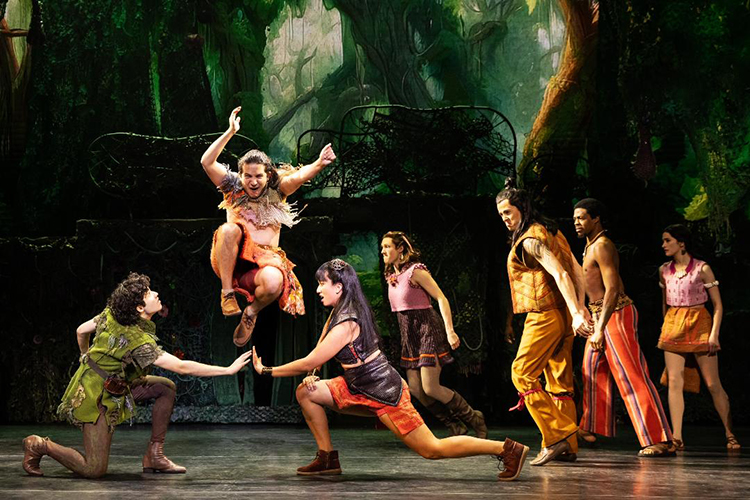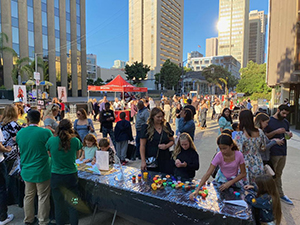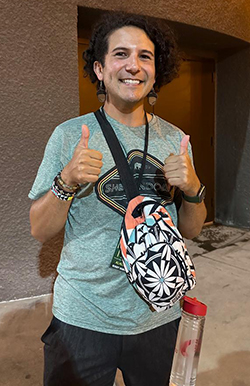
By Sandi Masori

SAN DIEGO — Walking to the Civic Theatre for Broadway San Diego’s Peter Pan, we were greeted by a surprise- it was family night for the show. The quad outside the theater was filled with activities: a coloring and play dough station, a fairy dust station, some behind-the-scenes displays, a green-screen photo booth, and themed cocktails for the adults.

It turns out that Broadway San Diego often does a family night for the shows that are more kid-oriented, so you may want to check the website to see when the next one is. Looking around the plaza, it was evident that the show attracts a multi-generational audience, and that many parents and grandparents were eager to introduce the next generation to this beloved classic tale.
Just in case you don’t know the story of Peter Pan, it’s the story of a perpetual child who lives in Neverland and never grows up. He hangs out with other forever children called the lost boys, and fights pirates and Indians.
The curtain rises in the children’s bedroom of the Darling home. At first you might think that it’s the same Peter Pan that you saw as a child, but then you might notice the iPad on the floor. And if you didn’t notice it, Wendy (Hawa Kamara) and John (William Foon) start talking about making a viral video, letting us know, right from the start. that we are in modern times and things might be a little different.
Once we get into Neverland though we’re out of the modern world and firmly in the fantasy- with a major key difference, the way the Native Americans are portrayed. I’ll come back to this point in a bit.
First let’s go back to the bedroom, besides the beautifully detailed set by Anna Louizos, there were some pretty cool effects. After Peter Pan (Nolan Almeida) gets his shadow back, there’s a whimsical dance that he does with the shadow (flying on a harness of course), and there’s a fun moment when the shadow, of its own accord, grabs a picture on the wall and it actually moves. The flight scene, where the three Darling kids fly off to Neverland with Peter, is super effective with the LED projection screen creating the feeling of flight and traveling great distances.
The Neverland set is absolutely cinema graphic in the way that it blends 3D elements with the screen. It’s lush and inviting and enjoyable to look at.
The production is fun and high energy throughout. The five minors in the show all did an incredible job. This includes 17-year old Southern California native Almeida in the title role. The other minors are Foon as John, Camden Kwok as Michael, Levi Chrisopulos as a twin, and Zaynn Arora as the other twin. Their performances were on par with the more seasoned actors in the show.
Other standouts were Kenny Ramos as Acoma, one of the Native Americans, Kurt Perry as Smee, and Cody Garcia as Hook.
The fight scenes and choreography also deserve recognition. They are engaging and fascinating to watch.
The show has been reimagined from the original “Mary Martin” Broadway version. One of the biggest differences is that the screenplay was readapted by Larissa Fasthorse, a Native American playwright. She changed the way that the indigenous people in the show are portrayed, making them more realistic and representative of real tribes. As part of this overhaul, actual Native Americans are cast in each production and the character names and costumes reflect the real heritage of the actors playing those roles.

Kenny Ramos is from our local Barona/ Kumeyaay Nation and was one of the actors who came out after the show to talk to us at the chatback. He told how much he disliked the way that indigenous people were portrayed in the original. I was curious to know more about that, and why he thought that the original version was so harmful. He graciously stayed late after the chatback to talk with me a little more and explain his thoughts.
In the original version, the indigenous people are put on the same level as mermaids and other fantasy characters. They depicted a characterization that is based more on stereotypes than actual indigenous people.
In a previous version, indigenous people were called redskins or savages, spoke in broken English, and had a number called “Ugg-a-wug” that used jibberish lyrics. That number has been replaced by a song called “Friends Forever” in which the Native Americans and the Darling children teach each other some dances from their respective cultures.
Ramos shared with me that he has struggled as an actor with misrepresentations of native people in various shows in which he was cast, and feeling like his voice was silenced when he tried to correct those misrepresentations.
We talked about how important it is for kids to see themselves in the characters on stage, and also for other children to not learn about a people based on a stereotype. He also shared how he felt uneasy when he was cast as Hispanic characters, feeling like he was taking the job away from someone from that community.
This made me think about the conversations that we have been having in the Jewish community about representation- can only Jews play a Jew? Can Jews only play Jews and not other non-Jewish characters? Is this limiting or expansive? These questions keep coming up both in film and theater. On the one hand, actors should be able to transform themselves into any character, that’s what acting is. On the other hand, space needs to be made for people who have otherwise been underrepresented. But can that space be made while still delivering the escape and entertainment that the audience is seeking? I think Peter Pan does a good job striking that balance. As one older woman at the chatback said, she saw the original with Mary Martin on Broadway as a child, and this version delivers the same emotional wonder and joy as that one did.
It’s a very short run though so if you want to get in on it, do it quick, the show ends its run here on Sunday.
*
Sandi Masori is a theater and restaurant reviewer for San Diego Jewish World.